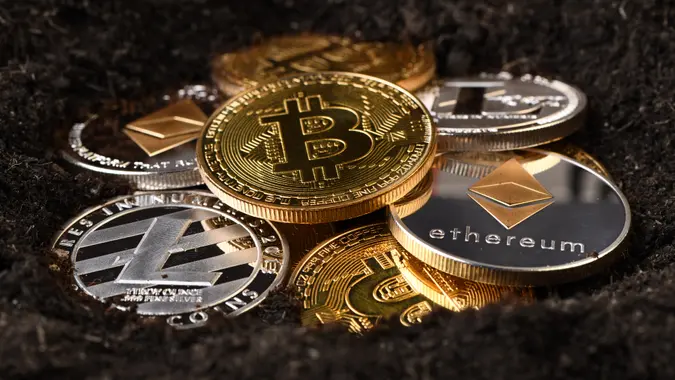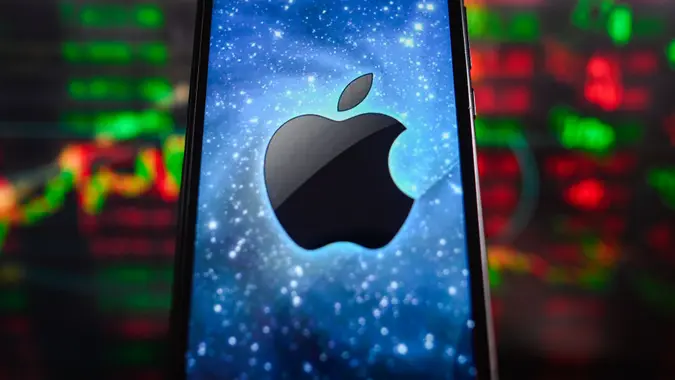Stolen Crypto Worth $3.6 Billion Recovered by DOJ: Bitfinex’s Unus Sed Leo Surges

Commitment to Our Readers
GOBankingRates' editorial team is committed to bringing you unbiased reviews and information. We use data-driven methodologies to evaluate financial products and services - our reviews and ratings are not influenced by advertisers. You can read more about our editorial guidelines and our products and services review methodology.

20 Years
Helping You Live Richer

Reviewed
by Experts

Trusted by
Millions of Readers
On Feb. 8, the U.S. Justice Department (DOJ) announced it had arrested two individuals for an alleged conspiracy to launder cryptocurrency stolen during the 2016 hack of Bitfinex — crypto presently valued at approximately $4.5 billion. Thus far, law enforcement officials have seized over $3.6 billion in crypto linked to that hack — the largest financial seizure ever, per a DOJ press release.
Following the announcement, the cryptocurrency known as Unus Sed Leo, which was issued in part to recapitalize the Bitfinex exchange following the 2016 hack, surged more than 50%, Bloomberg reported.
On Feb. 9, the crypto was up 37%, according to CoinMarketCap.
Cryptocurrency Analysts Hail Historic Recovery of Stolen Crypto
Stephane Ouelette, co-founder and CEO of institutional crypto-platform FRNT Financial, told GOBankingRates that “for those of us who have been in the space for a while, it’s hard to imagine a more significant announcement [than the recovery announcement].”
“In spite of the benign market action post-announcement, our expectation is that this will positively impact the counterparty risk assessment of the crypto ecosystem that continues to limit many large/institutional investors from participating in the space,” Ouelette said.
“Now, a prospective crypto investor can think that not only are large exchanges more sophisticated and very well-capitalized but even in the tail-risk event of a hack, the recovery potential is very real. In a space with a lot of noisy and trite headlines — this is a real and significant positive development for Bitcoin and cryptocurrency as a whole.”
In a Feb. 8 announcement on its website, Bitfinex said that it was pleased the DOJ had recovered a significant portion of the Bitcoin stolen during the Aug. 2016 security breach, and that it had been been cooperating extensively with the DOJ since its investigation began — and will continue to do so.
“Bitfinex will work with the DOJ and follow appropriate legal processes to establish our rights to a return of the stolen Bitcoin. Bitfinex intends to provide further updates on its efforts to obtain a return of the stolen Bitcoin as and when those updates are available,” the company said.
Bitfinex added that if it receives a recovery of the stolen bitcoin, as described in the Unus Sed Leo token whitepaper, “Bitfinex will, within 18 months of the date it receives that recovery use an amount equal to 80% of the recovered net funds to repurchase and burn outstanding Unus Sed Leo tokens. These token repurchases can be accomplished in open market transactions or by acquiring Unus Sed Leo in over-the-counter trades, including directly trading bitcoin for Unus Sed Leo.”
History of the Bitfinex Hack, Legal Moves Going Forward
On Aug. 2, 2016, Bitfinex suffered a hack, depleting the exchange of 119,756 BTC, according to the whitepaper. “To call this a huge loss is a gross understatement, and many exchanges would — and in similar circumstances did — throw in the towel in the face of seemingly insurmountable odds. Instead, the entire Bitfinex team remained united and worked together to find a solution to both save the platform and make everyone whole in under a year,” according to the whitepaper.
William Callahan, director of government and strategic affairs at cryptocurrency compliance and intelligence company Blockchain Intelligence Group, agreed. He told GOBankingRates: “The agents on this case showed their aptitude in navigating the complexities of crypto crimes, and agents, prosecutors and analysts will work just as hard in the coming months and years, as the agents did who executed this seizure. As we see a larger adoption of cryptocurrency, this case highlights the growing importance for law enforcement at all levels to build broader awareness and education relating to crypto crimes.”
Callahan added, however, that while the defendants will now make their way through a criminal legal process, the seized funds will also go through a legal forfeiture process, one that could take place as part of a criminal or civil action. This could tie the funds up for several years.
“Before the U.S. government writes a check for $4.5 billion to Bitfinex, potential victims or claimants may file a legal action, and make a claim for all or a portion of the funds. They will have an opportunity to prove that their claim is justified and will likely rely on blockchain analytics and expert testimony to support their claims,” he said.
More From GOBankingRates
- GOBankingRates’ Best Banks of 2022: Live Richer by Banking Better
- Gen Z and Millennials Favor National and Online Banks, Survey Shows — What Does That Mean for the Future of Credit Unions?
- How Has COVID-19 Impacted The 2022 Tax Season?
- 40% of Women Have Less Than $100 in Their Savings Accounts, New Survey Finds
 Written by
Written by  Edited by
Edited by 

























